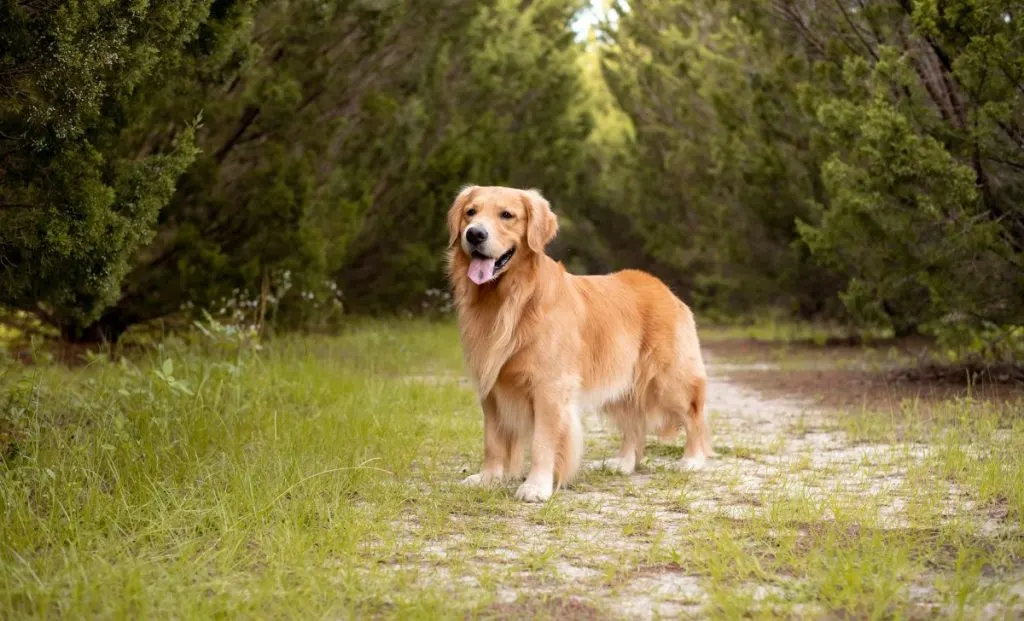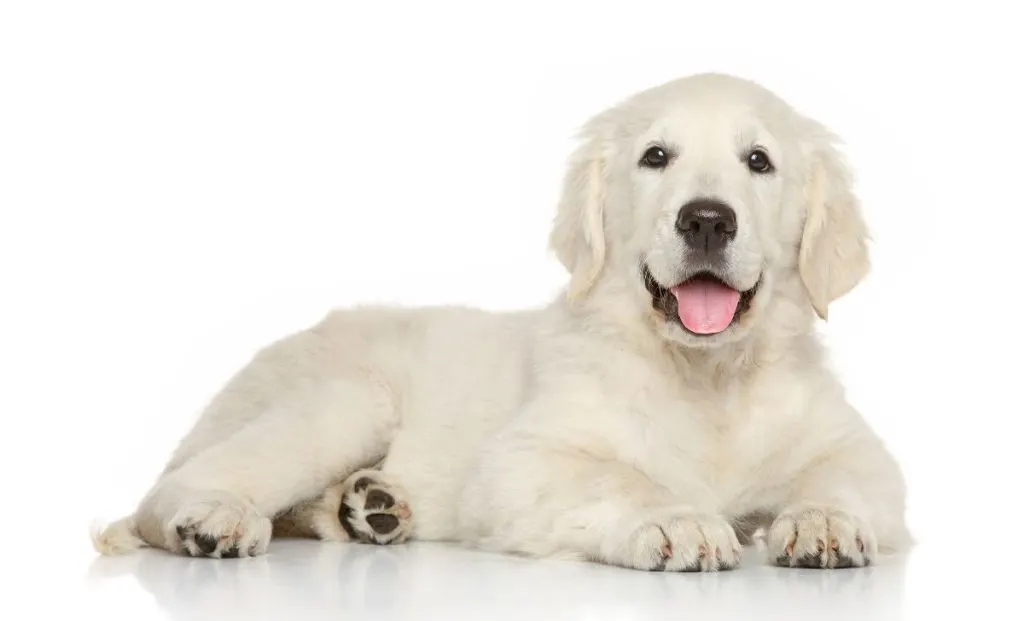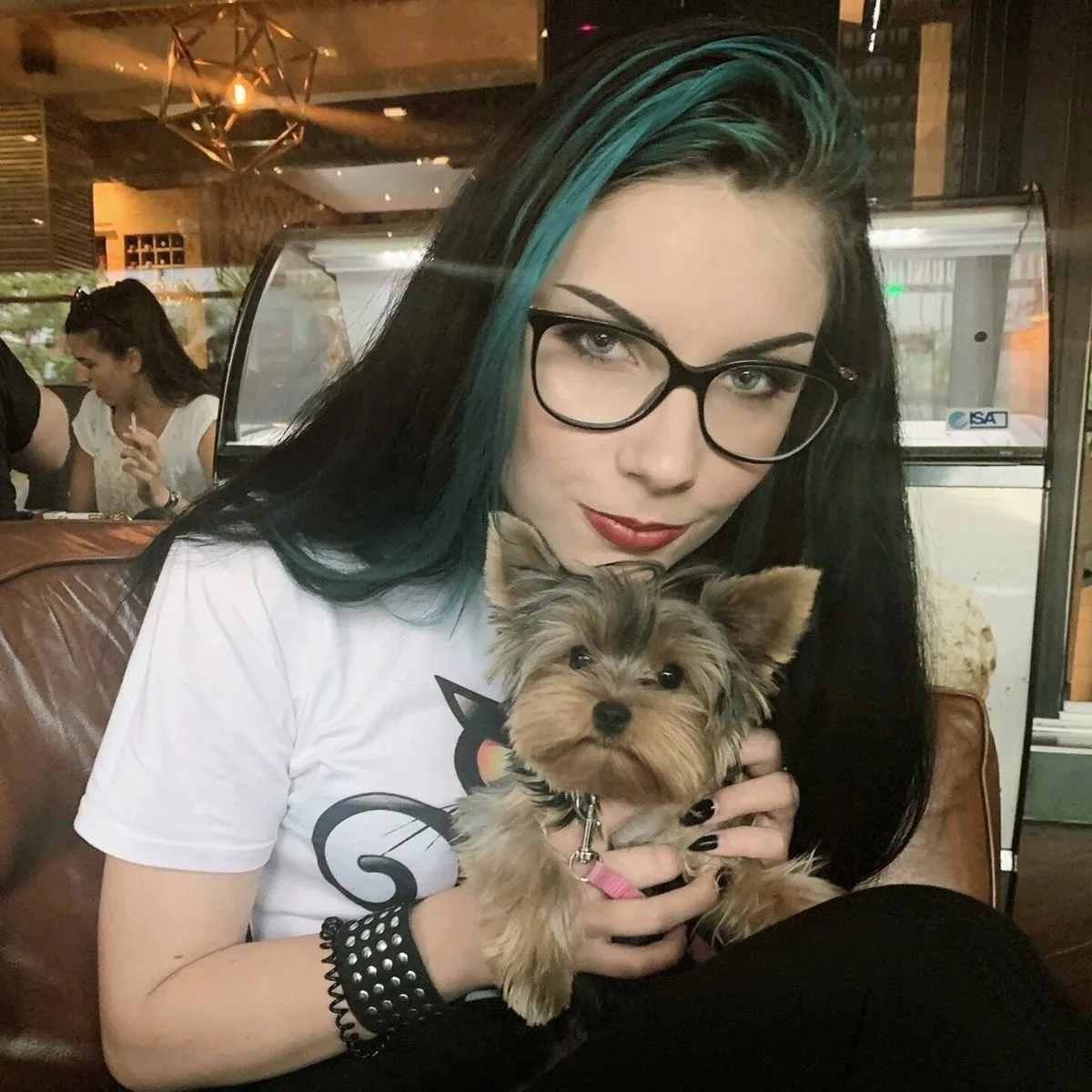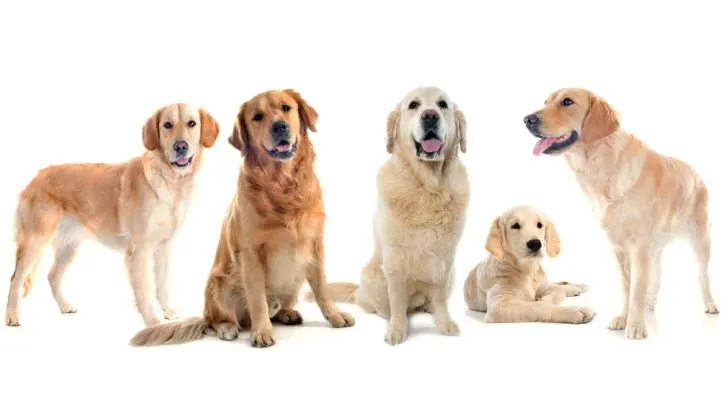They’re cute, they’re loveable, and they’re absolutely beautiful. Yes, I’m talking about Golden Retrievers! Everyone knows this breed. But did you know that there are three Golden Retriever colors these pups can come in?
When someone mentions Golden Retrievers, we immediately imagine happy yellow-haired dogs with long coats and a big smile on their face. However, these pups can come in more than one color, at least according to the breed standard.
This beloved breed was originally bred to be gun dogs but quickly became one of the most loved family dogs in the world. One of the reasons behind this is its friendly temperament. The other is its beautiful coat color.
Here is everything you need to know about Golden Retriever colors and other physical traits that make these pups so adorable.
Official Golden Retriever Colors
All registered dog breeds need to adhere to a certain breed standard that is set by the main kennel club in the area. If you live in the United States, this is the American Kennel Club (AKC).
Other major kennel clubs include the United Kennel Club (UKC) and the Fédération Cynologique Internationale (FCI).
According to the AKC, these dogs have a coat that is “rich, lustrous golden of various shades.” White markings aren’t allowed, other than a few white hairs on the dog’s chest. Also, feathering may be lighter, but this isn’t to be confused with any markings.
At the same time, AKC recognizes three different Golden Retriever colors. Here’s what they are:
1. Gold Golden Retrievers

First off, we have a color most of these dogs are known for: The gold Golden Retriever.
This is the classic Golden Retriever look. Their long coats come in a rich gold shade, and most reputable breeders prefer this trait.
At a closer look, you might notice a few white hairs here and there, but even this should be as rare as possible. Of course, signs of aging are allowed, as these cannot be controlled.
These pups typically do well in dog shows, provided they have other physical characteristics that are considered desirable by the AKC’s breed standard, such as a stocky build, feathering on the neck, legs, underside, and tail, and luscious, thick coats.
2. Dark Golden Retrievers

Also known as red Golden Retrievers, these pups come in a few shades, from bright ginger and striking red to a deeper mahogany coat color.
No one would ever argue that these Golden Retrievers are beautiful. However, dark and red colors are not desirable according to any kennel club, so they are mostly reserved for field Goldies that won’t participate in dog shows and will be used as gun dogs or for rescue work.
This doesn’t mean that there is anything particularly wrong with pups that come in this shade. Kennel clubs and the judges simply prefer a lighter coat color, which is why many breeders don’t breed darker Golden Retrievers.
Differences Of The Red Golden Retriever
Next to the obvious shade difference, there are a few other things that set dark Golden Retrievers apart from their golden counterparts.
If you take a good look, you’ll notice that these pups have a shorter and straighter coat than classic Golden Retrievers.
In fact, their coat might resemble the Labrador Retriever hair!
Also, these pups typically have less feathering on their legs and tails due to their rescue work heritage. However, this can vary, and you can find red Goldies with various types of coats.
This is because the standard isn’t as strict with these dogs as it is with other, more desirable body colors. In the end, most of these pups won’t ever be allowed to participate in larger conformation shows.
3. Cream Golden Retrievers

Out of all the different colors Goldies come in, cream is probably the most special one.
Most people know them because of the English Cream Golden Retrievers, but there is more to the color. And no, despite what some might say, they are not a separate breed.
This is the lightest variation of beautiful Golden Retrievers. They are the lightest color of them all, and many owners prefer them over the other colors as they are somewhat rare, at least when compared to their darker cousins.
Still, the American Kennel Club doesn’t seem to agree, as most conformation shows consider this color to be too light. According to them, good Golden Retrievers should come in a solid gold color, and anything that’s too light or too dark is not desirable.
Why Are Cream Golden Retrievers Special?
There are many myths regarding the lightest color of Golden Retrievers.
Some consider them to be the healthiest and the friendliest of all Golden Retrievers, although the Golden Retriever Club of America disagrees and says all Goldies are the same and this is just a marketing trick, just like selling them under the name white Golden Retrievers is.
One reason why this might be true, though, is that cream Goldens were bred to be family pets and not pups for rescue work and other tasks. This means the breeding program for reproducing them uses dogs that not only look the part but have loveable personalities.
As for the health claim, there might be some truth to that, as well. The reason is that most cream Goldies sold in the US are descendants of the English Cream Golden Retrievers.
A few studies have shown that around 40% of English Golden Retrievers will suffer from cancer throughout their lifespan, while the numbers are around 60% for American Golden Retrievers, which are typically darker in color.(1)(2)
It’s easy to conclude that Golden Retriever puppies who are close descendants from English bloodlines will be healthier than those who were bred in the US for tens of generations.
Other than that, there are a few more differences that make the cream Goldies different from the rest – and most of these are also due to their English lineage:
- Cream Golden Retrievers have a more muscular build and a blocker head.
- Their coat is often a bit longer than the coat of the standard gold Golden Retriever.
- They are favored by the UKC and FCI, as these kennel clubs prefer lighter colors of Golden Retrievers.
Unofficial Golden Retriever Colors

Next to these three, you might find some breeders selling Golden Retrievers in a few other colors, such as black, white, or even bi-color.
I hate to give you the hard truth: These advertisements are scams, and the people selling these dogs are backyard breeders, puppy mills, or simply unethical breeders who are just looking to take your money.
While there are many different shades of Golden Retrievers, they don’t literally come in a variety of colors – just in several golden hues.
So, if you see someone selling white Golden Retrievers, they are either selling cream Goldens that are so light they have a white hue or some Golden Retriever mix.
You should never fall for these cash-grabs. Sure, those pups might look pretty, but chances are they are prone to various health issues due to improper breeding practices.
If a breeder is ready to claim their dog is something he isn’t, who knows what else they are lying about?
Of course, this doesn’t necessarily mean that a breeder is intentionally trying to deceive you. Some people who ended up with a litter of puppies in a different color might truly believe that they are selling or giving away some rare Golden Retriever colors.
Still, no responsible breeder will ever claim their Golden Retriever is in any other color other than the three I’ve listed.
Does Black Golden Retriever Exist?
There are rumors about the existence of black-coated Golden, the rarest Golden Retriever of them all. These dogs have all the characteristics of a standard Golden Retriever puppy, except their coats are solid black in color.
Unfortunately, this, too, is a scam. There is no such thing as a black Golden Retriever.
What is being sold as one is most likely a crossbreed of a standard Golden Retriever and a black Labrador Retriever.
While black isn’t a color that occurs in Goldens, it is quite common in their cousins, Labs. When crossbreeding the two, chances are you’ll get a dog that inherits the black coat from a Lab with the long hair of a Golden Retriever.
Once again, I advise you not to buy a dog that is being advertised as a black Golden Retriever.
There is nothing wrong with purchasing a crossbreed – if you are aware that this is what you’re buying. Crossbreeds are amazing pets, just like purebred dogs.
However, if you buy a dog that is being sold as a purebred but is actually a mutt, you are most likely not going to be aware of some possible behavioral or genetic concerns.
Two Types Of Golden Retrievers And Their Colors
I have already mentioned that dark red Golden Retrievers are usually ‘field Goldies’. What does this term mean?
There are two types of Goldies:
- Field Golden Retrievers
- Show Golden Retrievers
Field Golden Retrievers were bred for dog sports as gun dogs to retrieve waterfowl and game birds. They were not meant to participate in dog shows, and as such, appearance wasn’t a priority during the breeding process.
This means that field Goldens are usually in colors that aren’t acceptable conformation shows – such as dark gold.
On the other hand, show Golden Retrievers are bred to adhere to the breed standard. They often come from champion bloodlines, and their appearance is extremely important.
This is why all show Goldens are bred in colors that AKC considers desirable, such as pure gold.
This doesn’t mean that all gold Golden Retrievers are show quality. Breed standard decides on a few other features, such as size, build, and temperament. However, coat color is one of the vital physical traits.
American Vs. English Golden Retriever
Another way in which you can differentiate types of Golden Retrievers is by their origin. In other words, you can find:
- American Golden Retrievers
- English Golden Retrievers
The American Golden Retrievers are bred according to the AKC’s standard. Most of the Goldens in the US are this type, and most of them come in a bright gold color.
English Golden Retrievers, on the other hand, were bred to be considered desirable by the UKC and FCI, and they are more common in Europe.
These Golden Retrievers are lighter in color, and this shade is considered more beautiful on that side of the ocean.
They also tend to have a bit longer coats and softer fur, as well as bulkier bodies and a somewhat larger head.
So, if you’ve seen Golden Retrievers in Europe and wondered why they look different from the American variants you’re used to seeing – this is why. It all comes down to the different breed standards.
Of course, this doesn’t mean that either variant is better. It’s just what’s preferred in a certain area. Most Goldens that are accepted by the UKC or FCI will be accepted by the AKC, and vice versa.
This difference doesn’t matter much unless you are planning on participating in dog shows.
Does Golden Retriever Coat Color Matter?
All dogs deserve love equally, no matter their color, shape, and size. However, picking the right Golden Retriever color can make a difference.
Certain colors exist in the breed’s genetics. They are one of the indications that the dog is bred according to the standard, which also includes temperament and health.
If a dog comes in a faulty color, this often means that he isn’t purebred or that the color is connected to some behavioral or health issues. This isn’t just about the looks, but also about the wellbeing of your beloved pooch.
Of course, this doesn’t necessarily mean that a dog will get sick or behave badly just because he comes in the ‘wrong’ color. He simply won’t be as predictable as a dog with a pedigree that comes in standard shades.
In the end, it is all up to you and your desires and expectations. Golden Retrievers are amazing family pets, no matter their color. Whichever one you choose, you won’t make a mistake.
References:
(1) Dobson JM. Breed-predispositions to cancer in pedigree dogs. ISRN Vet Sci. 2013 Jan 17;2013:941275. doi: 10.1155/2013/941275. PMID: 23738139; PMCID: PMC3658424.
(2) Dr. Karen Shaw Becker for Mercola.com. Why Do Some Dogs Develop Tumors More Than Others?

Vanja’s passion for writing started at an early age, which is why she pursued Journalism as her college degree. She can research any topic and find all the information before you bat an eye, which is a great thing for her job but a terrible one for her husband.
Even as a young child, she fell in love with everything fluffy – but dogs have a special place in her heart due to her childhood companion, a Corgie named Archie.
Motivated by her experiences and driven by a desire to give back to her four-legged companions, she spends her free time volunteering at a local dog shelter.
